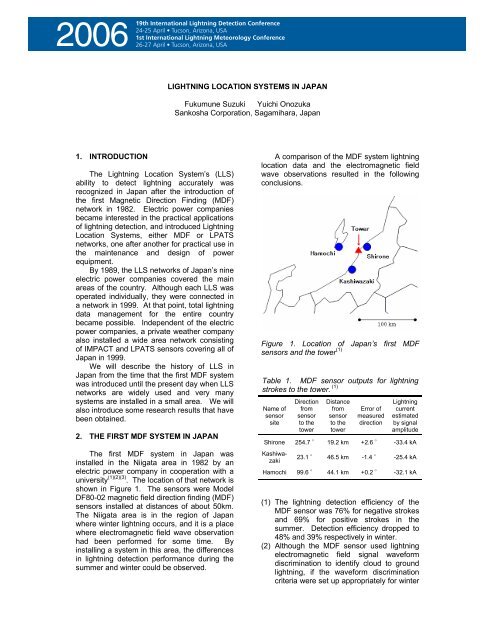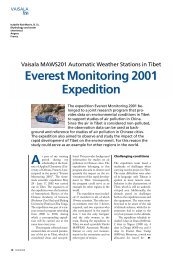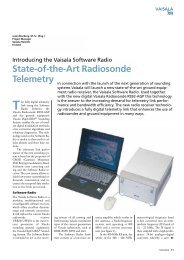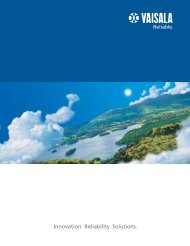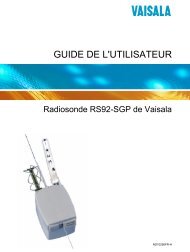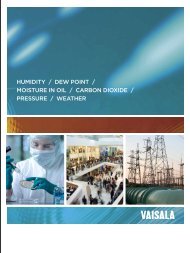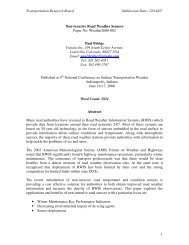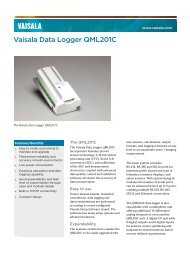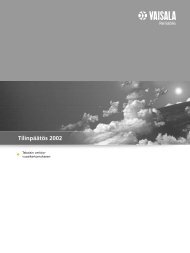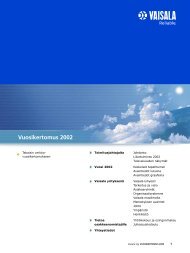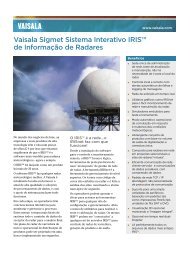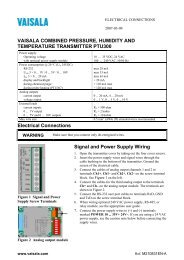LIGHTNING LOCATION SYSTEMS IN JAPAN Fukumune ... - Vaisala
LIGHTNING LOCATION SYSTEMS IN JAPAN Fukumune ... - Vaisala
LIGHTNING LOCATION SYSTEMS IN JAPAN Fukumune ... - Vaisala
You also want an ePaper? Increase the reach of your titles
YUMPU automatically turns print PDFs into web optimized ePapers that Google loves.
200619thInternational Lightning Detection Conference24-25 April • Tucson, Arizona, USA1st International Lightning Meteorology Conference26-27 April • Tucson, Arizona, USA<strong>LIGHTN<strong>IN</strong>G</strong> <strong>LOCATION</strong> <strong>SYSTEMS</strong> <strong>IN</strong> <strong>JAPAN</strong><strong>Fukumune</strong> Suzuki Yuichi OnozukaSankosha Corporation, Sagamihara, Japan1. <strong>IN</strong>TRODUCTIONThe Lightning Location System’s (LLS)ability to detect lightning accurately wasrecognized in Japan after the introduction ofthe first Magnetic Direction Finding (MDF)network in 1982. Electric power companiesbecame interested in the practical applicationsof lightning detection, and introduced LightningLocation Systems, either MDF or LPATSnetworks, one after another for practical use inthe maintenance and design of powerequipment.By 1989, the LLS networks of Japan’s nineelectric power companies covered the mainareas of the country. Although each LLS wasoperated individually, they were connected ina network in 1999. At that point, total lightningdata management for the entire countrybecame possible. Independent of the electricpower companies, a private weather companyalso installed a wide area network consistingof IMPACT and LPATS sensors covering all ofJapan in 1999.We will describe the history of LLS inJapan from the time that the first MDF systemwas introduced until the present day when LLSnetworks are widely used and very manysystems are installed in a small area. We willalso introduce some research results that havebeen obtained.2. THE FIRST MDF SYSTEM <strong>IN</strong> <strong>JAPAN</strong>The first MDF system in Japan wasinstalled in the Niigata area in 1982 by anelectric power company in cooperation with auniversity (1)(2)(3) . The location of that network isshown in Figure 1. The sensors were ModelDF80-02 magnetic field direction finding (MDF)sensors installed at distances of about 50km.The Niigata area is in the region of Japanwhere winter lightning occurs, and it is a placewhere electromagnetic field wave observationhad been performed for some time. Byinstalling a system in this area, the differencesin lightning detection performance during thesummer and winter could be observed.A comparison of the MDF system lightninglocation data and the electromagnetic fieldwave observations resulted in the followingconclusions.Figure 1. Location of Japan’s first MDFsensors and the tower (1)Table 1. MDF sensor outputs for lightningstrokes to the tower. (1)Name ofsensorsiteDirectionfromsensorto thetowerDistancefromsensorto thetowerError ofmeasureddirectionLightningcurrentestimatedby signalamplitudeShirone 254.7 ° 19.2 km +2.6 ° -33.4 kAKashiwazaki23.1 ° 46.5 km -1.4 ° -25.4 kAHamochi 99.6 ° 44.1 km +0.2 ° -32.1 kA(1) The lightning detection efficiency of theMDF sensor was 76% for negative strokesand 69% for positive strokes in thesummer. Detection efficiency dropped to48% and 39% respectively in winter.(2) Although the MDF sensor used lightningelectromagnetic field signal waveformdiscrimination to identify cloud to groundlightning, if the waveform discriminationcriteria were set up appropriately for winter
lightning, it would be possible to achievethe same detection efficiency as insummer.(3) The relationship between distance anddetection efficiency for negative lightningin summer was in line with results reportedafter television camera observations inNorth America.(4) Applying the transmission line model, thefirst stroke of negative lightning calculatedfrom the magnetic field signal strengthobtained by the MDF system agreed wellwith the direct measurements taken inEurope of the first negative lightning strokestarted by a downward leader.(5) In comparing MDF system outputs withactual measurements of lightning strikecurrent, the difference was 15%, and thedirection measurement error of the MDFsensor was less than 2.6 degrees (refer toTable 1).The MDF system offers the big advantagethat lightning can be detected over a widerange. The lightning positions near the Niigataarea reported by the MDF system for onemonth in July (summer) and December(winter) 1984 are shown in Figure 2 (4) . Itshows that many lightning strikes occurred inthe mountain area in summer. Conversely,few lightning strikes occurred in the mountainsin winter and some lightning occurred over thesea and along the coast. Although thelightning detection efficiency of this system isreduced at a distance of 400km or more, somedistant events were also detected. Thelightning locations reported on December 11,1983 are shown in Figure 3. This shows thelightning generated with the passage of a coldfront. Lightning activity is seen while the coldfront passes through the Sea of Japan, but notwhen it passes through the mountains. Whenthe front moves to the Pacific Ocean, lightningactivity increases again. This pattern is seenin winter, and it is caused by the thundercloudwhich progresses by the large differences intemperature of the warm sea and the cold airaccompanying the cold front. These resultsare in agreement with generally acceptedmeteorological theory.One problem associated with lightningdirection measurements using an MDF systemis the direction measurement error called SiteError. The problem of directional error hasbeen studied extensively and methods forimplementing corrections have beendeveloped (5)(6) .(a) July, 1984 (summer)(b) December, 1984 (winter)Figure 2. Lightning locations near the Niigataarea observed by the MDF system in July1984 (summer) and December 1984 (winter) (4)Figure 3. Lightning locations detected by theMDF system on December 11, 1983(Simultaneous locations over the Sea of Japanand the Pacific Ocean) (4)3. ELECTRIC POWER COMPANY MDFAND LPATS <strong>SYSTEMS</strong>The electric power companies recognizedthe practical applications of accurate lightningdetection and introduced LLS networks (MDFor LPATS systems) one after another for use
in power equipment maintenance and thedevelopment of lightning-proof designs. TheLPATS or time of arrival (TOA) type LLS wasfirst installed in Japan in 1989. At the time,each electric power company was usingCIGRE type lightning discharge counters toobserve lightning occurrences in their area.Those systems were gradually replaced byLLS networks. By 1989, LLS systems ownedby the nine Japanese electric powercompanies covered the main areas of Japan.The location of those LLS sensors in 1991 isshown in Figure 4 (7) .Although each electric power companyLLS was operated independently, a systemthat collected the data from the networks wasdeveloped in 1999, and it became possible torecord national lightning data continuously,and evaluate lightning frequency andcharacteristics without regionaldifferences (8)(9)(10)(11) . A national Japanthunderstorm day map was created with datafrom the past decade (Figure 5). Although thisthunderstorm day map was almost equivalentto the conventional IKL map (Figure 6), thenew lightning frequency map showed regionaldifferences in much more detail, and it wasconcluded that the lightning frequency mapobtained using the LLS was a more suitabletool for the design of power equipment thanthe conventional IKL map.Figure 5. Lightning stroke frequency mapcreated using the electric power company LLSnetwork data in the summer, 2000 (11)Figure 6. The conventional IKL map (11)Figure 4. Location of Japanese LLS sensorsin 1991 (7)In the meantime, system evaluations wereperformed in parallel with lightningobservations. Detection equipmentimprovement and replacement and networkexpansion resulted in improved locationaccuracy and system reliability. The IMPACTsensor that combined MDF and TOAtechnology was introduced for the first time in1994, and it was confirmed that it providedimproved location accuracy (12)(13) . Moreover,the IMPACT sensor made it possible to detect
the lightning location of every stroke.Comparisons of the current values for everystroke revealed that 37% of multi strokelightning had subsequent strokes with biggercurrent values than the first stroke. It was alsoreported that the value defining the 50%confidence ellipse improved from 2.21km to0.85km when MDF sensors were replacedwith IMPACT sensors in 1998. (14) Thelocations of the LLS sensors in 2005 is shownin Figure 7(a). Many of the MDF systemswere updated to IMPACT, and the LPATSnetworks were also replaced with IMPACTsensor systems.An example of a typical IMPACT sensorinstallation in Japan is shown in Figure 8 (15) .The sensor is installed on a cabinet containinga communication device and a power unit.Lightning data is transmitted directly to acentral processing unit.Figure 7(b). Location of Japanese LLSsensors in 2005 (Weather Company) (16)Figure 7(a). Location of Japanese LLSsensors in 2005 (Electric Power Companies)(14)Figure 8. A typical IMPACT Sensor installation(15)4. WEATHER COMPANY IMPACT ANDLPATS <strong>SYSTEMS</strong>A weather company introduced the firstLPATS-III sensors in Japan in 1988. Thelocation of those five sensors in 1991 is shownin Figure 4. Another weather company startednetwork construction in 1991. By improving itssensors and expanding its network, thatcompany completed a wide area system thatcovered all of Japan in 1999. This systemconsists of 12 IMPACT sensors and 17
LPATS-IV sensors. The location of thosesensors in 2005 is shown in Figure 7(b) (16) .This system can detect lightning over a widerange, not only in Japan but also in thesurrounding areas as shown in the observationexample in Figures 9 (17)(18) . Data from thenetwork is provided in real time to generalusers and is used in the development ofstatistical materials such as a lightning densitymaps. (19)Figure 9. Lightning discharges detected by theJLDN on August 6, 2003. The color of symbolsvaries every 6 hours from blue to green toyellow and to red. (18)5. SAFIR AND LDARAmong other LLS systems in Japan,SAFIR and LDAR networks have also beeninstalled. The main purpose of these systemsis to locate the source of lightning dischargeby detecting the electromagnetic signals in theVHF band. SAFIR sensors were installedfirstly in 1992 as part of a joint university andelectric power company research project (20) . Anational SAFIR network consisting of about 30sensors was installed by a governmentorganization in 2000. The application of thisnetwork is limited and lightning data andinformation regarding system performancehave not been made available, but aphotograph of a network sensor and anexample of the data generated by the SAFIRnetwork are introduced on a government website (21) . An electric power company installedthe first commercial version LDAR network(LDAR II) in Japan in 2000 (22) .5. CONCLUSIONTwenty years or more have passed sincethe first MDF system was introduced in Japan.Since that time, the electric power companieshave covered the whole country with theirindependent networks, a private weathercompany has installed a mixed wide areanetwork covering the entire nation, and agovernment organization has installed anational network of SAFIR sensors. There aremore than one hundred lightning sensorscurrently operating in Japan. Also, it shouldbe noted that all of the main commerciallightning location systems, MDF, LPATS,IMPACT, SAFIR, and LDAR have beendeployed in Japan.Japan is not a country with a particularlylarge number of thunderstorms, but the powerand communication systems are built in verydense networks and damage caused bylightning is very serious. Winter lightningoccurs frequently resulting in damage toequipment. Focusing their energy on lightningresearch has proven to be very valuable forthe electric power industry in Japan and theinstallation of new LLS equipment andupgrades is expected to continue in the future.5. REFERENCE(1) J. Hojo, M. Ishii, T. Kawamura, F. Suzuki,R. Funayama, M. Shiogama: “LightningParameter Obtained by Lightning LocationSystem and Its Analysis”, IEEJ, ED-85-60,HV-85-11, pp.17-26, 1985 (in Japanese)(2) J. Hojo, M. Ishii, T. Kawamura, F. Suzuki,H. Komuro, M. Shiogama: “Characteristicsand Appraisal Method on theElectromagnetic Wave Accompanied byCloud-to-Ground Lightning Flash”, Trans.of IEEJ, Vol.108-B, No.4, pp395-402, 1996(in Japanese)(3) J. Hojo, M. Ishii, T. Kawamura, F. Suzuki,H. Komuro, M. Shiogama: “SeasonalVariation of Cloud-to-Ground LightningFlash Characteristics in the Coastal Areaof Sea of Japan”, JGR, Vol.94, No.D11,pp.13207-13212, 1989(4) T. Kawamura, F. Suzuki, M. Ishii, J. Hojo,R. Funayama, M. Shiogama: “Analysis ofLightning Active Area Observed byLightning Location System”, IEEJ, ED-85-
61, HV-85-12, pp.27-36, 1985 (inJapanese)(5) F. Suzuki, T. Kawamura, M. Ishii, J. Hojo,R. Funayama, M. Shiogama: “Influence ofthe Near Obstacle to the Detection ofLightning Direction by the Magnetic Field”,IEEJ, ED-87-89, HV-87-36, pp.53-61,1987 (in Japanese)(6) Y. Miyake, M. Ishii, T. Kawamura, N.Honma: “On the Site Error of Wide BandMagnetic Direction Finder”, Trans. IEE ofJapan, 115-B, No.7, 1995(7) Investigating R&D Committee on LightningObservation, “The Latest LightningObservation Technology and the FutureSubject”, Technical Report of IEEJ,No.487, 1994 (in Japanese)(8) The Subcommittee of Lightning ProtectionDesign, “Lightning location system inJapan and a lightning frequency mapusing the data obtained by them”, Trans.of IEEJ, Vol.116-B, No.4, pp395-402, 1996(in Japanese)(9) T. Suda, T. Shindo, S. Yokoyama, S.Tomita, A. Wada, A. Tanimura, N. Honma,S. Taniguchi, M. Shimizu, T. Sakai, Y.Sonoi, K. Yamada, M. Komori, K. Ikesue,K. Toda: “Lightning Occurrence DataObserved with Lightning Location SystemOperated by Power Utilities in Japan”, 24 thICLP, No.2a.5, pp.168-172, 1998(10) T. Suda, T. Shindo, S. Yokoyama, S.Tomita, A. Wada, A. Tanimura, N. Honma,S. Taniguchi, M. Shimizu, N. Itamoto, K.Ikeda, S. Kawamoto, M. Komori, K.Ikesue, K. Toda: “Lightning OccurrenceData Observed with Lightning LocationSystem of Electric Utilities in Japan: 1992-2001”, IEEJ, ED-03-178, SP-03-100, HV-03-93, pp.135-139, 2003 (in Japanese)(11) The Committee of Lightning ProtectionDesign, Lightning Database WorkingGroup: “Lightning Occurrence DataObserved with Lightning Location Systemof Electric Utilities in Japan: 1992-2001”Trans. IEE of Japan, 114-B, No.10,pp.1255-1261, 2004(12) N. Honma, F. Suzuki, M. Ishii:“Introduction of IMPACT to LLP System onTohoku Area”, IEEJ, ED-94-106, HV-94-65, pp.107-115, 1994 (in Japanese)(13) N. Honma, K. Suzuki, F. Suzuki, M. Ishii:“Evaluation of the Location CalculationTechnique of Tohoku Area LLP System”,IEEJ, ED-95-173, HV-95-44, pp.35-44,1995 (in Japanese)(14) M. Shimizu, H. Tani: “Evaluation of theAccuracy of the Lightning Location System- Improvement to the location accuracyusing a time-of-arrival method”, Researchand development News of Chubu ElectricPower Co., Inc., No.85, pp.9-10 (2000) (inJapanese)(15) F. Suzuki, Y. Serikawa, Y. Onozuka“Evaluation of the "StrikeGuard" LightningAlarm Sensor Using Lightning LocationSystem (LLS) Lightning Data”, The 3 rdAsian Lightning Protection Forum, pp.15-19, 2005(16) M. Matsui, Y Miyake, S. Takahashi: “TheIntroduction of the Japan LightningDetection Network”, 17 th ILDC (1998)(17) M. Ishii, T. Shindo, N. Honma, Y. Miyake:“Lightning Location System in Japan”, 25 thICLP, No.2.10, pp.161-165 (2000)(18) A. Sugita, M. Matsui: “Lightning inTyphoons Observed by JLDN”, 18 th ILDC,No.20, (2004)(19) Franklin Japan Corporation StatisticsData, http://www.fjc.co.jp/jldn/data.html(20) Y. Sonoi, Z. Kawasaki, K, Matsuura, T.Matsui, N. Shimokura, “Collation with theWeather Radar Echo and LightningObservation Result by SAFIR”, Trans. ofIEEJ, Vol.113-B, pp987-993, 1993 (inJapanese)(21) Tokyo Aviation Weather Service Center ofJapan Meteorological Agency,http://www.tokyojma.go.jp/home/haneda/gyoumu/kansoku/liden/liden.html(22) T. Shioda, T. Narita, T. Yamada, N.Okabe, E. Zaima, “Observation of theLightning Development Aspect by LDAR”,2001 National Convention, 7-014, 2001 (inJapanese)


